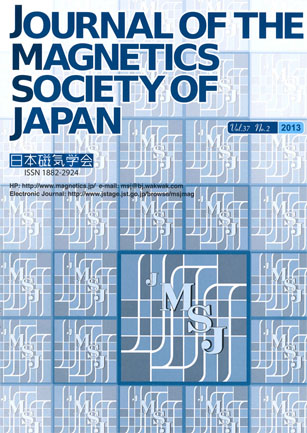巻号一覧
39 巻, 4 号
選択された号の論文の6件中1~6を表示しています
- |<
- <
- 1
- >
- >|
Review Article
-
T. Kohashi2015 年 39 巻 4 号 p. 131-138
発行日: 2015/07/01
公開日: 2015/07/10
[早期公開] 公開日: 2015/06/12ジャーナル オープンアクセスSpin-polarized scanning electron microscopy (spin SEM) is a method to observe magnetic domain structures at a ferromagnetic sample surface. It detects the spin-polarization of the secondary electrons from a ferromagnetic sample and the magnetization vector at the originating point of the secondary electrons is deduced. This principle has brought us several excellent capabilities such as high spatial resolution and magnetization vector analysis. This technique has been applied for various magnetic materials and devices since it was developed thirty years ago, and still has been continuously extending its functions and challenging to open new fields for magnetic domain observation. In this article, recent results of spin SEM are introduced after brief explanation of the principle and the key components of the instrument.抄録全体を表示PDF形式でダウンロード (1079K)
Magnetic Recording
-
T. Kobayashi, Y. Isowaki, Y. Fujiwara2015 年 39 巻 4 号 p. 139-146
発行日: 2015/07/01
公開日: 2015/07/10
[早期公開] 公開日: 2015/06/12ジャーナル オープンアクセスMedia for heat-assisted magnetic recording (HAMR) are designed with a minimized anisotropy constant ratio Ku / Kbulk by using a model calculation. The design method is improved from the previous rough estimation approach to a statistical estimation of the thermal stability factor of media during writing and rewriting. A comparison is made between HAMR and HAMR combined with shingled magnetic recording. The many relationships between the design parameters and Ku / Kbulk are revealed. The parameters are the thickness of the recording layer, the thermal conductivity of interlayer 1, the light-spot diameter, the heat-spot diameter, the linear velocity, the writing temperature, the grain number per bit, and the standard deviation of the grain size. In certain cases, the limiting factor for obtaining the minimum Ku / Kbulk value is information stability during 10 years of archiving, which relates to improving media preparation to increase Ku / Kbulk. In other cases, the limiting factor is the information stability on the trailing side located 1 bit from the writing position during writing and in the adjacent tracks during rewriting, which relates to examining the media structure to increase the heat-transfer thermal gradients.抄録全体を表示PDF形式でダウンロード (3490K)
Hard and Soft Magnetic Materials
-
M. Koide, K. Kakizaki, K. Kamishima2015 年 39 巻 4 号 p. 147-150
発行日: 2015/07/01
公開日: 2015/07/10
[早期公開] 公開日: 2015/06/12ジャーナル オープンアクセスWe have investigated the synthesis conditions, and the magnetic properties of BaFe2+2Fe3+16O27 (Fe2W) and Ba2Fe2+2Fe3+12O22 (Fe2Y). It is found that Fe2W can be synthesized at a sintering temperature of 1300°C and Fe2Y can be synthesized at a sintering temperature of 1000°C. The X-ray diffraction patterns for Fe2W and Fe2Y samples are in good agreement with the pattern of BaCo2+2Fe3+16O27 (Co2W) and that of Ba2Co2+2Fe3+12O22 (Co2Y). It is also found that the Curie temperatures of Fe2W and Fe2Y ferrites are 503 and 375°C, respectively.抄録全体を表示PDF形式でダウンロード (2213K)
Spin Electronics
-
Micromagnetic simulation of spin wave propagation in a ferromagnetic film with different thicknessesHiroshi Hata, Takahiro Moriyama, Kenji Tanabe, Kensuke Kobayashi, Ryo ...2015 年 39 巻 4 号 p. 151-155
発行日: 2015/07/01
公開日: 2015/07/10
[早期公開] 公開日: 2015/06/12ジャーナル オープンアクセスWe have shown by micromagnetic simulation that the wavelength of the spin wave (SW) is modulated when the SW propagates across a step between two ferromagnetic films with different thicknesses. Since the wavelength of the SW depends on the film thickness, the thickness difference works as the different medium in Snell’s law. The wavelength modulation obtained by the simulation showed a good agreement with Snell’s law.抄録全体を表示PDF形式でダウンロード (1257K)
Measurement Technique, High-frequency Devices
-
S. Yabukami, K. Takahashi, T. Ozawa, O. Fujioka, T. Nagano, S. Hashi, ...2015 年 39 巻 4 号 p. 156-160
発行日: 2015/07/01
公開日: 2015/07/10
ジャーナル オープンアクセスA new tracking system for a wireless magnetic ribbon type marker has been developed by using high-speed analog-to-digital [A/D] converters and a field programmable gate array (FPGA) module. The quality factor of the resonated marker (ribbon: 38 mm in length and 4 mm in width) was about 130. The standard deviation (position accuracy) was smaller than ~1/10 that of the previous system because the sampling frequency of the A/D converters was more than 100 times higher and because the FPGA operated at high speed. The distance between the driving coil and the pickup coil array was ~820 mm, which was ~2.7 times larger than that in the previously reported system. The profile of the marker we obtained was relatively smooth and reasonable up to a distance of 475 mm from the pickup coil array.抄録全体を表示PDF形式でダウンロード (1820K)
Power Magnetics
-
Shinji Isogami, Takuya Sakai, Masatoshi Kanamaru, Yasunobu Inaba, Masa ...2015 年 39 巻 4 号 p. 161-165
発行日: 2015/07/01
公開日: 2015/07/10
ジャーナル オープンアクセスA prototype magnetizing fixture was designed based on magnetic flux patterns simulated using the three-dimensional finite-element method of the JMAG software package. Rectangular shaped anisotropic bond magnets with dimensions of 6×12×24 mm were magnetized to multipoles using the prototype and a pulse power source. The result was significant enhancement perpendicular to the surface component of magnetic flux density (Bz) in the hard-axis compared with Bz for conventional simple magnets, of which the front and back surfaces are magnetized to opposite polarities. Moreover, Bz reached the close value for the Halbach arrayed magnet, 0.24 T, with the same body size fabricated for the attainment target. The enhanced Bz was attributed to the cusp field formed by the flux from both side coils. Demonstrations indicated that the cusp field out of the easy-axis could be efficiently enhanced due to focusing of the flux.抄録全体を表示PDF形式でダウンロード (1058K)
- |<
- <
- 1
- >
- >|
